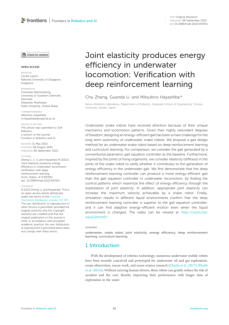Studies of ROV concepts 2022 - Part B







Date of publication: 2022
Authors:
D. Ross Robertson, Luke Tornabene, Claudia C.
Lardizabal, & Carole C. Baldwin.
This paper intents to prove that submersibles can
efficiently collect reef fishes of a broad range of taxa,
ecotypes, and sizes, leading to a more comprehensive
understanding of the regional GC deep-reef fish fauna.

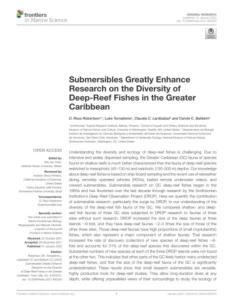

Date of publication: 2022
Authors: Qianrong Li & Baoji Zhang
The resistance performance and motion stability of
deep-sea remotely operated vehicles (ROVs) subjected
to underwater motion conditions are based on the
unsteady Reynolds-averaged Navier-Stokes method
combined with the six-degree-of-freedom equation of
motion to quickly and accurately predict them. In the
modeling process, the authors consider the
complexity of ROV geometry and thus reduce the
model to a series of regular geometries to maximize
the position and weight of the original components.

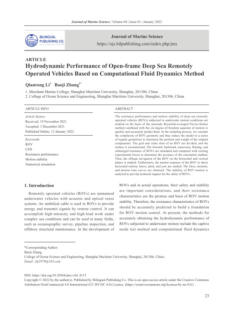

Authors:
Samuel M. Youssef, MennaAllah Soliman, Mahmood A.
Saleh, Mostafa A. Mousa, Mahmoud Elsamanty, &
Ahmed G. Radwan.
Nature and biological creatures are sources of inspiration.
Engineers have aspired to emulate these natural systems.
As rigid systems become increasingly limited in their
capabilities to perform complex tasks and adapt to their
environment like living creatures, the need for soft systems
has become more prominent due to the similar complex,
compliant, and flexible characteristics they share with
intelligent natural systems. This review provides an
overview of the recent developments in the soft robotics
field, focusing on the underwater application frontier.

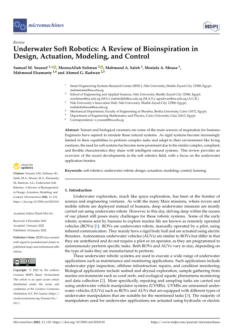

Authors:
Bing Sun, Wen Pang, Mingzhi Chen, Daqi Zhu
This paper presents the design of a new type of search
and rescue remotely operated vehicle (ROV) system. The
goal is to achieve the underwater target search
and detection and small target capture and rescue
operation requirements.
First, the overall design of the whole underwater surface
system and the layout design of the propulsion system are
given.

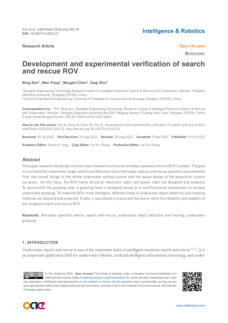

Authors:
Alexander Konoplin, Nikita Konoplin, and Alexander
Yurmanov
This article considers the issues of development of a
smart system for supporting activities of ROV operators
and its practical implementation for the efficient operation
of a ROV Comanche 18 that is based on the R/V
Akademik M.A. Lavrentiev. The system uses algorithms that
provide coordinated movements of the ROV and its
depressor unit. These algorithms are designed for ROVs to
make synchronous, accurate, and accident-free
movements along long-distance routes even when
launched from a support vessel without dynamic
positioning (DP).

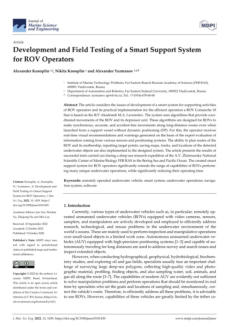

Authors: Malte von Benzon, Jesper Liniger, Fredrik Fogh
Sørensen, Simon Pedersen
Marine growth on offshore underwater structures is a
problem as it reduces the lifespan. The structures are
cleaned annually by manually operated ROVs.
Automation of these ROVs can improve the removal
efficiency, and thereby reduce the cleaning campaign
time and cost, as it is challenging for the operators to
manually stabilize the ROVs under the harsh off shore
conditions. Waves, ocean currents, the attached tether
and the cleaning tool all generate external forces to the
ROVs acting as substantial disturbances which can be
rejected by a controller. This study examines the operating
range of a standard compact ROV subject to external
disturbances.

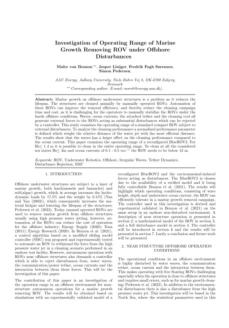

Authors: Yanhu Chen, Luning Zhang, & Yucheng Ling
This study proposes an underwater free-space optical
communication method of transmitting information.
The characteristics of underwater optical transmission
and the photoelectric signal processing and modulation
and demodulation algorithms are studied and modeled.

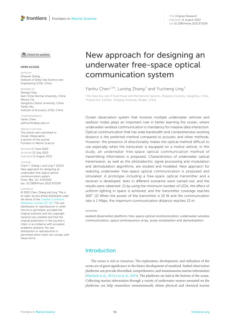

Authors: Ioannis Polymenis, Maryam Haroutunian,
Rose Norman, & David Trodden
There have been recent breakthroughs in Artifcial
Intelligence (AI) and, notably, Deep Learning (DL) models
and applications. These have widespread usage in various
fields, including unmanned aerial vehicles and
autonomous vehicles, car navigation, and other
applications. However, they are not as prevalent in
underwater applications due to the difficulty of obtaining
underwater datasets for a specific application. In this
sense, the current study utilizes recent advancements in
DL to construct a bespoke dataset generated from
photographs of items captured in a laboratory
environment.

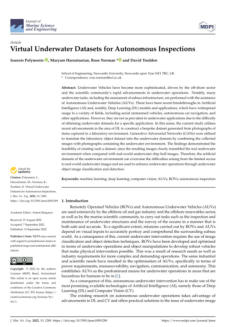

Authors: Tingjun Lei, Guoming Li, Chaomin Luo, Li
Zhang, Lantao Liu, & Richard Stephen Gates
Many real-world robot applications in precision
agriculture, poultry farms, disaster response, and
environment monitoring require search, locate, and
removal (SLR) operations by autonomous mobile robots.
In such application settings, the robots initially search and
explore the entire workspace to find the targets so that the
subsequent robots conveniently move directly to the
targets to fulfill the task. A multi-layer robot navigation
system is necessary for SLR operations. The scenario of
interest is the removal of broiler mortality by autonomous
robots in poultry barns in this paper.



Authors: Ruiheng Liao, Wei Su, Xiurong Wu, & En Cheng
Unmanned underwater vehicles (UUVs) that are widely
utilized for underwater environment detection and
underwater resource exploration have to be localized by
underwater acoustic sensor networks (UASNs).
However, localization accuracy is hard to guarantee due
to the limited bandwidths, long propagation latency, and
limited energy resources of the UASNs.
This paper proposes a reinforcement learning (RL) and
neural network-based mobile underwater localization
scheme to optimize the anchor node selection in the
UASNs to localize the target precisely.

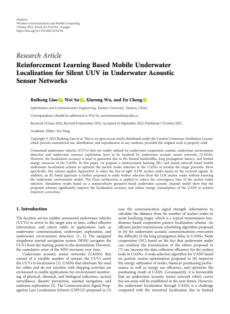

Authors: Chao-Lin Kuo , Yu-Chi Pu, and Qi-An Chen
A remotely operated underwater vehicle (ROV) is crucial
in ocean exploration and underwater missions.
An ROV is manipulated through a tether cable by an
operator on shore or mother boat, and it can be used
for underwater observations or as a robotic arm to
take samples back.
The position control and movement of an ROV are not
stable due to buoyancy, ocean current, and surge
waves. To overcome the influence of these disturbances
on the ROV, the authors propose a switch proportional-
integral (PI) controller combined with a buck-boost
converter (BBC) to process the ROV’s position following. In
this paper, a six-axis ROV was designed and implemented.



Authors: Zhenjing Zhu, Ning Hu, Junyi Wu, Wenxin Li,
Jiabao Zhao, Maofa Wang, Fanzong Zeng,
Huajie Dai, and Yongju Zheng.
Researchers use underwater acoustic equipment to
explore the unknown ocean environment, which is
one of the important means to understand and utilize
the ocean. For underwater acoustic equipment, the
application of underwater acoustic metamaterials is the
premise to ensure and improve the performance of
underwater acoustic communication, acoustic stealth, and
sonar detection.

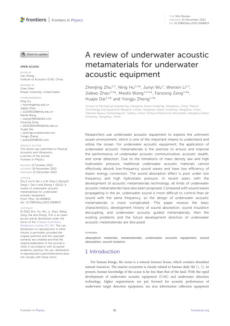

Authors: Yongji Zhang, Yu Jiang, Hong Qi, Minghao hao,
Yuehang Wang, Kai Wang, Fenglin We
The marine environment presents unique challenges
for human–robot interaction. Communicating with
gestures is a common way for interacting between the
diver and autonomous underwater vehicles (AUVs).
However, underwater gesture recognition is a
challenging visual task for AUVs due to light refraction
and wavelength color attenuation issues. Current gesture
recognition methods classify the whole image directly or
locate the hand position first and then classify the hand
features. Among these purely visual approaches, textual
information is largely ignored. This paper proposes a
visual–textual model for underwater hand gesture
recognition (VT-UHGR).



Authors: Yalçın Ata, Hanaa Abumarshoud, Lina Bariah,
Sami Muhaidat, and Muhammad Ali Imran
Intelligent reflecting surfaces (IRSs) offer a paradigm shift
towards enhancing wireless communications capabilities.
Using this emerging technology in underwater wireless
systems is a promising solution to overcome the limitations
pertinent to such challenging environments. In this paper,
we quantify the performance enhancement offered by
integrating IRS technology in the context of underwater
optical wireless communication (OWC). Specifically, the
authors derive a closed-form expression for the outage
probability over log-normal channels, considering the
underwater attenuation, pointing error, and turbulence
effects.



Authors: Ali F.Kaeib, Omar .A. Alshawish, Suhayl Ali Altayf,
Mohammed A. Gamoudi
Underwater wireless communications have more
attention daily due to their wide applications in the
military and the scientific community. It is also useful in
vehicles and devices deployed underwater, which are
challenging to connect with wires. Acoustic
communications mostly use underwater technology
nowadays, which suffers from limited bandwidth and
capacity. For this reason, complementary technology
like underwater wireless optical communication (UOWC)
will be in the field. This paper simulated the UOWC system
with Optisystem software to measure the maximum
distances in different underwater mediums.

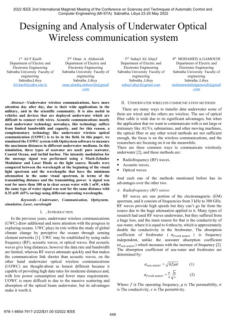

Authors: Le Yu, Han Sun, Shangwei Su, Huixuan Tang,
Hao Sun, and Xiaoyu Zhang
Based on the analysis of the development status of
underwater wireless power transmission technology,
this paper puts forward the challenges of underwater
wireless power transmission, and summarizes the
electromagnetic coupler structure, underwater docking
mode, compensation topology, control method, and
eddy current loss. The present research hotspots in the
field of underwater wireless power transmission are
summarized and analyzed. Finally, according to the
development trend of technology, the urgent technical
problems in underwater wireless power transmission are
expounded.

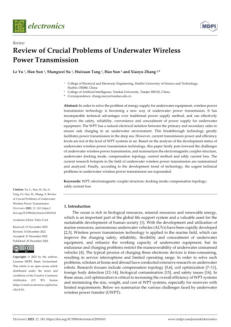

Authors: Tao Yan, Zhe Xu, Simon X. Yang, S. Andrew
Gadsden
This paper presents a comprehensive overview of
recent developments in formation control of multiple
autonomous underwater vehicles (AUVs). Several
commonly used structures and approaches for
formation coordination are listed, and the advantages
and deficiencies of each method are discussed. The
difficulties confronted in synthesis of a practical AUVs
formation system are clarified and analyzed in terms of
the characteristic of AUVs, adverse underwater
environments, and communication constraints. The
state-of-the-art solutions available for addressing these
challenges are reviewed comprehensively.

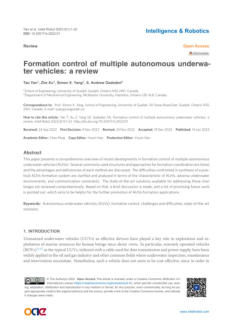

Authors: Dianyu Yang, Chensheng Cheng, Can Wang,
Guang Pan and Feihu Zhang
The AUV (Autonomous Underwater Vehicle) navigation
process relies on the interaction of a variety of sensors. The
side-scan sonar can collect underwater images and obtain
semantic underwater environment information after
processing, which will help improve the ability of AUV
autonomous navigation. However, there is no practical
method to utilize the semantic information of side scan
sonar image. A new convolutional neural network model
is proposed to solve this problem in this paper.

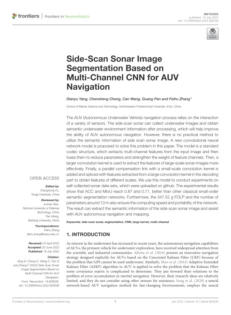

Authors: Xiaofei Du, Chaoyong Zong, Bo Zhang, and
Maolin Shi
AUV docking devices have the ability to achieve homing
of the AUV, supply the AUV with energy, and exchange
data with it, thus improving the endurance and ensuring
the continuous long-term and large scale operation of the
AUV. To improve the successful docking rate of the AUV,
a funnel-shaped underwater docking device with multi-
degree freedom based on a deep-sea platform was
designed in this paper.

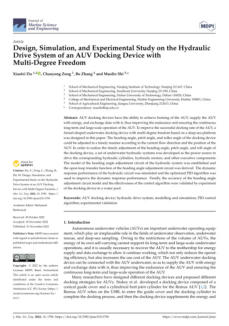

Authors:
Sean T. Frey, A. B. M. Tahidul Haque, Ravi Tutika,Elizabeth
V. Krotz, Chanhong Lee, Cole B. Haverkamp, Eric J.
Markvicka , Michael D. Bartlett
Cephalopods, such as the octopus, use suckers to
generate adhesion and suction forces. Their grippers are
particularly attractive for underwater gripping, as the
adhesives are reversible, attachments can be activated
quickly, and adhesion can be achieved on diverse
substrates under both dry and wet conditions.

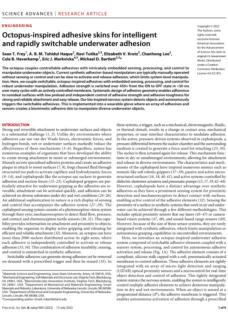

Authors:
Xiaonan Huang, Zach J. Patterson, Andrew P. Sabelhaus,
Weicheng Huang, Kiyn Chin, Zhijian Ren, Mohammad
Khalid Jawed, and Carmel Majidi
Despite tremendous progress in the development of
untethered soft robots in recent years, existing systems
lack the mobility, model-based control, and motion
planning capabilities of their piecewise rigid counterparts.
This study introduces a framework for physics-based
modeling, motion planning, and control of a fully
untethered swimming soft robot.

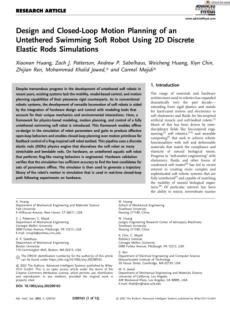

Authors:
EeShan C. Bhatt, Bradley Howard, and Henrik Schmidt
This article presents a tactical decision-aid framework for a
human decision-maker collaborating with an autonomous
underwater vehicle (AUV) to integrate the vertical sound
speed profile for underwater navigation and
communication. During the pre-deployment phase, the
authors use modeled and real oceanographic data. They
load basis function representations of the sound-speed
perturbations onto one or more AUVs on deck, where a
handful of weights can estimate a sound-speed profile.

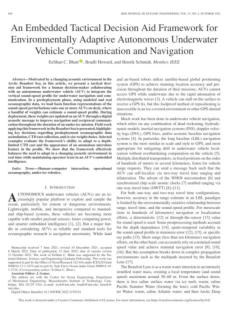

Authors:
David Herrero-Pérez, Humberto Martínez-Barberá
Underwater manipulation with current robotics
technology is a challenging task with significant limitations
in versatility and robustness terms. Such functionality has
tremendous potential covering a broad spectrum of
applications, mainly replacing divers performing
hazardous jobs. Soft robotics provide an efficient solution
for operating in these scenarios and adapting to uncertain
environmental conditions. This paper presents the design
and fabrication of a simple, low-cost, and easily deployable
soft gripper for underwater manipulation.

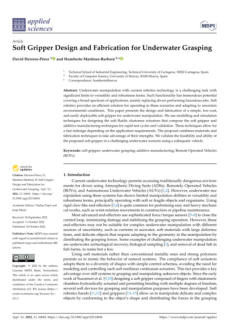

Authors:
Miao Zhang, Haibao Hu, Peng Du, Xiaopeng Chen,
Zhuoyue Li, Chao Wang, Lu Cheng, Zijian Tang
This document proposes a new hydrodynamic artificial
intelligence (AI) detection method to achieve accurate
detection of “Internal Solitary Waves (ISWs)” by an
underwater vehicle. Two deep convolutional neural
network structures are established to predict the relative
position between the underwater vehicle and ISW and
the flow field around the underwater vehicle.
Combining field observation data and the computational
fluid dynamics (CFD) method achieves accurate numerical
simulation of the motion of the underwater vehicle in a
real ISW environment.

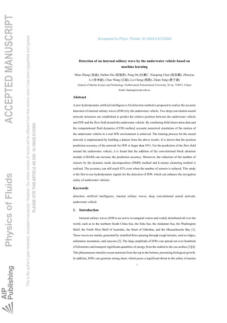

Authors: Chang Shi, Xide Cheng, Zuyuan Liu, Kunyu
Han, Penghui Liu, and Long Jiang
Disturbance is generated, and a wake remains that
destroys the original free surface and produces a new
wake when a vehicle moves underwater. To study the
mechanism and characteristics of the wave-making wake
generated by the maneuvering motion of an underwater
vehicle in density-stratified fluid, the k-E model and the
VOF method based on the RANS equation were used in
this paper to analyze the SUBOFF model in stratified fluid
at different drift angles.

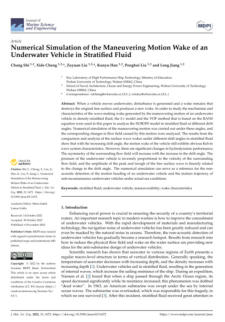

Authors: Hao Cao, and Lihua Wen
This paper presents the results of research on the noise
generated by an underwater vehicle in its operational
state. The study combines the large eddy simulation
turbulence model and Lighthill’s acoustic analogy
theory and extracts the transient flow field data as the
excitation conditions for acoustic calculations. The results
of the numerical calculations of the external
acoustic field were obtained under the vehicle wall
pressure pulsation, Lighthill volume excitation
condition, and the vibration excitation condition of the
underwater vehicle.

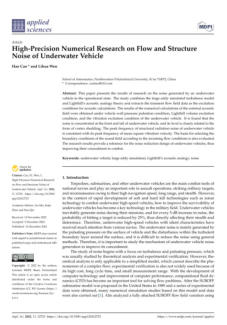

Authors:
Leif Christensen, José de Gea Fernández, Marc
Hildebrandt, Christian Ernst, Siegfried Koch, Bilal Wehbe
The objective of this manuscript is to scrutinize the latest
advancements in underwater robotics with a particular
emphasis on the utilization of artificial intelligence (AI) for
model learning, robot control, perception,navigation, as
well as manipulation.



Authors:
Chin-Chun Chang, Naomi A. Ubina, Shyi-Chyi Cheng,
Hsun-Yu Lan, Kuan-Chu Chen, and Chin-Chao Huang
This paper introduces a dual-mode underwater
surveillance camera system that includes a sonar imaging
device and a stereo camera. The sonar component is
equipped with cloud-based AI capabilities that can
accurately calculate the number, distribution, and size of
fish within a dense school.

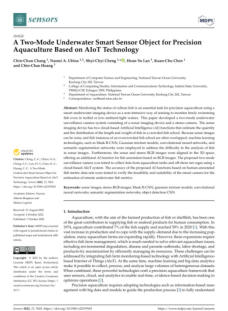

Authors: Antoni Burguera, and Francisco Bonin-Font
Recent studies show that machine learning, especially
deep learning, is effective in dealing with uncertainties in
underwater sensing. Despite their success in their
respective fields, the combination of machine learning
and underwater robotics has not been thoroughly
explored. This paper focuses on merging these fields and
explores the potential for machine learning to enhance
underwater robotics.

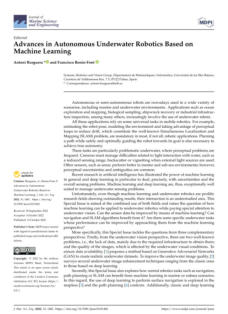


Click on the
octopus to return to
the top of the page



Authors: Bing Sun, Wen Pang, Mingzhi Chen, Daqi Zhu
This document describes the design and development of
a new type of search and rescue remotely operated
vehicle (ROV) system. It outlines the goals, design process,
and testing phases of the ROV and emphasizes its
capabilities in underwater target search, detection, and
small target capture and rescue operations.



Authors:
Jiabao Zhao, Ning Hu, Junyi Wu, Wenxin Li, Zhenjing
Zhu, Maofa Wang, Yongju Zheng, and Huajie Dai
This paper reviews the current applications and future
prospects of piezoelectric metamaterials in underwater
equipment. It discusses the challenges faced by traditional
materials in marine environments and highlights the
advantages of using piezoelectric metamaterials for sound
insulation and energy conversion, providing an overview
of the advancements and potential developments in this
field.

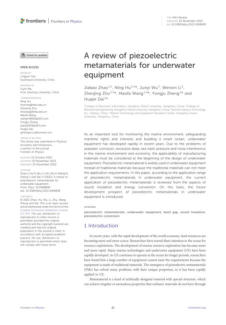

Authors: Eito Sato, Hailong Liu, Yasuaki Orita, Norimitsu
Sakagami, and Takahiro Wada
This study focused on developing and evaluating a
cooperative path-following control method for remotely
operated underwater vehicles (ROVs) to reduce the
workload of human operators by assisting with automatic
control, allowing them to allocate more attention to visual
inspection tasks. It describes the methodology, experiment,
and results, highlighting the effectiveness of the proposed
method in improving task performance and reducing
operator workload compared to manual control.

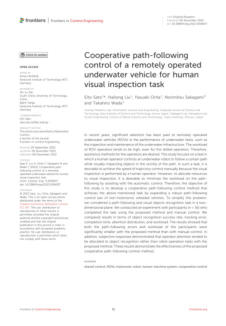



1 - Model Establishment and Parameter Identification of Remotely
Operated Vehicle (ROV).
Author: Yelei Zhang, Baoji Yin, Huifeng Jiao, Jian Zhang,
and Fei Yan
To study the dynamic characteristics of remotely operated
vehicle (ROV) underwater motion, a transformation matrix
was created, and the ROV's dynamics model was derived
using the Newton-Euler equation. The dynamic model
was simplified based on various characteristics. Pool
experiments used the least squares method to identify
parameters of dynamic models, comparing results with
the same control signals. Error analysis showed small
errors between theoretical and experimental values,
confirming the model's accuracy.
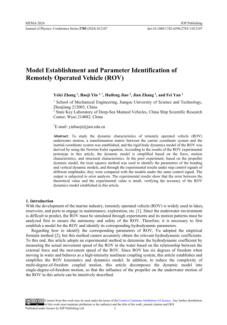


06 - Increasing the autonomy of an underwater ROV
Author: Marko Vuksic, Tonko Kovacevic, Barbara Dzaja,
Predrag Dukie, Slaven Sitie, Hai Nam Tran,
Vincent Rodin, Laurent Lemarchand, Valérie-
Anne Nicolas, Alain Plantec, Stéphane Rubini,
Frank Singhoff
Small presentation illustrating parts of ROVs that can be
optimized



21 - A Low-Delay Source-Location-Privacy Protection Scheme with
Multi-AUV Collaboration for Underwater Acoustic Sensor
Networks.
Authors: Xiaojing Tian, Xiujuan Du, Xiuxiu Liu, Lijuan
Wang, Lei Zhao
To protect source-location-privacy (SLP) in underwater
acoustic sensor networks (UASNs), a new low-delay
scheme called LDSLP-MA is proposed. It uses multipath
routing and multi-autonomous underwater vehicle (AUV)
collaboration to enhance protection while minimizing
delay. The scheme shows improved safety, reduced
energy use, and lower delays compared to existing
methods.
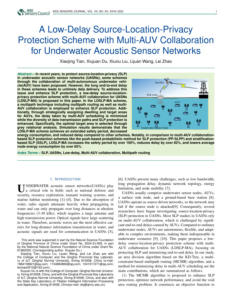



08 - Joint elasticity produces energy efficiency in underwater
locomotion: Verification with deep reinforcement learning
Author: Chu Zheng, Guanda Li, and Mitsuhiro
Hayashibe
Underwater snake robots face challenges in designing
energy-efficient gaits due to their unique mechanics and
locomotion patterns. A deep reinforcement learning and
curriculum learning method is proposed for underwater
snake robot gait design. The method compares the gait
generated by a conventional parametric gait equation
controller with elasticity in the robot's joints. The deep
reinforcement learning controller produces a more
energy-efficient gait than the gait equation controller,
maximizing energy efficiency and achieving maximum
velocity.
